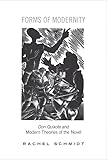Forms of Modernity : Don Quixote and Modern Theories of the Novel / Rachel Schmidt.
Material type: TextPublisher: Toronto : University of Toronto Press, [2011]Copyright date: ©2011Description: 1 online resource (384 p.)Content type:
TextPublisher: Toronto : University of Toronto Press, [2011]Copyright date: ©2011Description: 1 online resource (384 p.)Content type: - 9781442642515
- 9781442694187
- 809.3 22
- PN3491 .S35 2011eb
- online - DeGruyter
| Item type | Current library | Call number | URL | Status | Notes | Barcode | |
|---|---|---|---|---|---|---|---|
 eBook
eBook
|
Biblioteca "Angelicum" Pont. Univ. S.Tommaso d'Aquino Nuvola online | online - DeGruyter (Browse shelf(Opens below)) | Online access | Not for loan (Accesso limitato) | Accesso per gli utenti autorizzati / Access for authorized users | (dgr)9781442694187 |
Frontmatter -- Contents -- Preface -- Acknowledgments -- Abbreviations for Cited Material -- Note on Translations and Quotations -- 1. Don Quixote and the Problem of Modernity -- 2. Arabesques and the Modern Novel: Friedrich Schlegel’s Interpretation of Don Quixote -- 3. The Emptiness of the Arabesque: Georg Lukács’s Theory of the Novel -- 4. Ideas and Forms:Hermann Cohen’s Novelistics -- 5. The Poetics of Resuscitation: Unamuno’s Anti-Novelistics -- 6. Form Foreshortened: Ortega y Gasset’s Meditations on Don Quixote -- 7. Don Quixote in Bakhtin -- 8. Revolutions and the Novel -- Notes -- Bibliography -- Index
restricted access online access with authorization star
http://purl.org/coar/access_right/c_16ec
It's a critical cliché that Cervantes' Don Quixote is the first modern novel, but this distinction raises two fundamental questions. First, how does one define a novel? And second, what is the relationship between this genre and understandings of modernity? In Forms of Modernity, Rachel Schmidt examines how seminal theorists and philosophers have wrestled with the status of Cervantes' masterpiece as an 'exemplary novel', in turn contributing to the emergence of key concepts within genre theory.Schmidt's discussion covers the views of well-known thinkers such as Friedrich Schlegel, José Ortega y Gasset, and Mikhail Bakhtin, but also the pivotal contributions of philosophers such as Hermann Cohen and Miguel de Unamuno. These theorists' examinations of Cervantes's fictional knight errant character point to an ever-shifting boundary between the real and the virtual. Drawing from both intellectual and literary history, Forms of Modernity richly explores the development of the categories and theories that we use today to analyze and understand novels.
Mode of access: Internet via World Wide Web.
In English.
Description based on online resource; title from PDF title page (publisher's Web site, viewed 01. Dez 2023)


